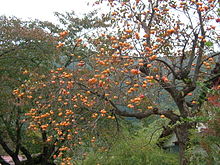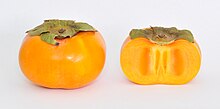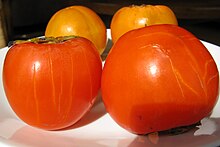Ultima modificare făcută de Adrian Pop; 25.09.2012 la 10:27.
www.popservice.ro
www.papornitamosului.ro
[U][COLOR=#800080][
e-mail - adipop@popservice.ro
ID Messenger: zalmoxa_adipop
skype - adrianpop58
http://www.sfatulbatranilor.ro/forum.php
https://www.facebook.com/groups/611112328972709/ - REGIA DE RECONSTRUCTIE A ROMANIEI
https:/https://www.facebook.com/grou...IZEGETUSA2050/ - Piciumanii doresc PACE
https://www.facebook.com/groups/1086016084901078/ - Avangarda de Sacrificiu

Three kaki fruits, one cut open.
The spherical to oval fruit bearing the indented stem and four sepals, can weigh up to 500 grams. The smooth, shiny and thin shell ranges in shade from yellow to red-orange. The slightly lighter fleshed fruits can contain up to eight seeds and may have an astringent taste. With increasing maturity, the fruit softens, similar to a kiwi.
The high content of tannin in the still-immature kaki provides a bitter component reminiscent of pear and apricot flavors, which becomes weaker with progressive maturation. The furry taste, caused by the tannins, is often reduced during the ripening process, or by frost. The very high proportion of beta-carotene (provitamin A) makes the kaki fruit nutritionally valuable.
Cultivation

Variety "Koushu-Hyakume" (astringent - for making it a dried Kaki)
Kaki are grown worldwide, with 90 percent of production in China, Japan and Korea. In East Asia the main harvest time for kaki is in the months of October and November. The trees have already lost their leaves by the time of harvest. Occasionally, the brightly colored fruit is left unharvested on the tree as a decorative effect.
In China, kaki has been cultivated since time immemorial. It is considered to have four virtues: it lives long, it gives a large area of shade, it is used by the birds as a nesting place, and it is not attacked by pests. A vase adorned with a kaki cake, a pine branch and an orange is a symbol of the desire "great happiness in 100 affairs".
Throughout Asia, different healing properties are attributed to the kaki. They are said to be helpful against stomach ailments and diarrhea. Immature fruits are said to be a treatment for fever, if they ripen in containers until they are sweet as honey. The juice of unripe fruit is said to lower the blood pressure and the fruit stem to relieve a cough. To reinforce these effects, the fruit is peeled before use, exposed to the sunlight during the day and to the dew at night, until a white powder coating forms.
Cultivation of this species at first spread through East Asia. Since the 19th century, kaki partially replaced date-plum (Diospyros lotus, also known as Caucasian persimmon) in some countries of South Europe and West Asia, because kaki has bigger fruits than date-plum; cultivation in California also began at that time.
The "Sharon" is a variegated form of Kaki from Israel, named after the fertile Plain of Sharon. It does not contain seeds and tastes more mild, since it clearly contains less tannin. Cross cut, the Sharon shows a star-shaped pattern of lines with darker flesh.
In Spain, there is a variegated form of Kaki, the "Ribera del Xuquer" of the Valencia region.
Kaki is also produced in Albania, mainly in Elbasan region.
Consumption
Remove the leaves before serving. The skin can be eaten (especially when the fruit is ripe and the tannins are almost completely decomposed), but many also remove the skin before eating. Also dried (after skinning & rinsing with shochu or after leaving 24hrs in hot spring water). 2 fruits are attached by a string which is then hung over a pole.
www.popservice.ro
www.papornitamosului.ro
[U][COLOR=#800080][
e-mail - adipop@popservice.ro
ID Messenger: zalmoxa_adipop
skype - adrianpop58
http://www.sfatulbatranilor.ro/forum.php
https://www.facebook.com/groups/611112328972709/ - REGIA DE RECONSTRUCTIE A ROMANIEI
https:/https://www.facebook.com/grou...IZEGETUSA2050/ - Piciumanii doresc PACE
https://www.facebook.com/groups/1086016084901078/ - Avangarda de Sacrificiu
www.popservice.ro
www.papornitamosului.ro
[U][COLOR=#800080][
e-mail - adipop@popservice.ro
ID Messenger: zalmoxa_adipop
skype - adrianpop58
http://www.sfatulbatranilor.ro/forum.php
https://www.facebook.com/groups/611112328972709/ - REGIA DE RECONSTRUCTIE A ROMANIEI
https:/https://www.facebook.com/grou...IZEGETUSA2050/ - Piciumanii doresc PACE
https://www.facebook.com/groups/1086016084901078/ - Avangarda de Sacrificiu
"Sharon Fruit" (named originally after Sharon plain in Israel) is an Israeli-bred cultivar of the D. kaki fruit. The cultivar is called 'Triumph'.[6] As with all pollination-variant-astringent persimmons, the fruit are ripened off the tree by exposing them to carbon dioxide. The sharon fruit has no core, is seedless, particularly sweet, and can be eaten whole.[7] Eating the sharon fruit regularly is believed to reduce the risk of developing atherosclerosis heart attacks.[8]

Nanyo City, Yamagata, Japan. October 2005.
The Date-plum (Diospyros lotus) is native to southwest Asia and southeast Europe. It was known to the ancient Greeks as "the fruit of the gods", or often referred to as "nature's candy" i.e. Dios pyros (lit. "the fire of Zeus"), hence the scientific name of the genus. Its English name probably derives from Persian Khormaloo خرمالو literally "Date-Plum", referring to the taste of this fruit which is reminiscent of both plums and dates. This species is one candidate for the lotus mentioned in the Odyssey: it was so delicious that those who ate it forgot about returning home and wanted to stay and eat lotus with the lotus-eaters.[9]
The American Persimmon (Diospyros virginiana) is native to the eastern United States and is higher in nutrients like vitamin C and calcium than the Japanese Persimmon.[10] Its fruit is traditionally eaten in a special steamed pudding in the Midwest and sometimes its timber is used as a substitute for ebony (e.g. in instruments).
The Black Persimmon or Black Sapote (Diospyros digyna) is native to Mexico. Its fruit has green skin and white flesh, which turns black when ripe.
The Mabolo or Velvet-apple (Diospyros discolor) is native to the Philippines. It is bright red when ripe. It is also native to China, where it is known as shizi. It is also known as Korean Mango.
The Indian Persimmon (Diospyros peregrina) is a slow growing tree, native to coastal West Bengal. It is green and turns yellow when ripe. It has an unremarkable flavor and is more known for its medicinal than its culinary uses.
There are many other species of Diospyros that are inedible to humans, and thus have little or no commercial value for their fruit.
Fruit

A whole Jiro persimmon fruit and a cross-section of one.

A ripe hachiya persimmon fruit

A ripe Persimmon fruit as suggested by their red color and cracking skins.The yellow ones in background are not ripe.

This is a sound, ripe kaki, soft enough for one to lift the calyx out cleanly and split the fruit for eating
Commercially, there are in general two types of persimmon fruit: astringent and non-astringent.
The heart-shaped Hachiya is the most common variety of astringent persimmon. Astringent persimmons contain very high levels of soluble tannins and are unpalatably astringent (or "furry" tasting) if eaten before completely softened. However, the sweet, delicate flavor of fully ripened persimmons of varieties that are astringent when unripe, is particularly relished. The astringency of tannins is removed in various ways. Examples include ripening by exposure to light for several days, and wrapping the fruit in paper (probably because this increases the ethylene concentration of the surrounding air). Ethylene ripening can be increased in reliability and evenness, and the process can be greatly accelerated, by adding ethylene gas to the atmosphere in which the fruit are stored. For domestic purposes the most convenient and effective process is to store the ripening persimmons in a clean, dry container together with other varieties of fruit that give off particularly large quantities of ethylene while they are ripening; apples and related fruits such as pears are effective, and so are bananas and several others. Other chemicals are used commercially in artificially ripening persimmons or delaying their ripening. Examples include alcohol and carbon dioxide which change tannin into the insoluble form. Such bletting processes sometimes are jumpstarted by exposing the fruit to cold or frost. The resultant cell damage stimulates the release of ethylene, which promotes cellular wall breakdown.
One traditional misconception is that persimmons are to be ripened till rotten. This is a confusion of the processes of controlled ripening with the processes of decay, possibly arising from problems of translation from Asiatic languages onto English. Rotting is the action of microorganisms such as fungi, and rotting persimmons are no better than any other rotting fruit. Sound persimmons should be ripened till they are fully soft, except that the carpels still might be softly chewy. At that stage the skin might be splitting and the calyx can easily be plucked out of the fruit before serving, which often is a good sign that the soft fruit is ready to eat.
Astringent varieties of persimmons also can be prepared for commercial purposes by drying. Tanenashi fruit will occasionally contain a seed or two, which can be planted and will yield a larger more vertical tree than when merely grafted onto the D. virginiana rootstock most commonly used in the U.S. Such seedling trees may produce fruit that bears more seeds, usually 6 to 8 per fruit, and the fruit itself may vary slightly from the parent tree. Seedlings are said to be more susceptible to root nematodes.
The non-astringent persimmon is squat like a tomato and is most commonly sold as fuyu. Non-astringent persimmons are not actually free of tannins as the term suggests, but rather are far less astringent before ripening, and lose more of their tannic quality sooner. Non-astringent persimmons may be consumed when still very firm, and remain edible when very soft.
There is a third type, less commonly available, the pollination-variant non-astringent persimmons. When fully pollinated, the flesh of these fruit is brown inside – known as goma in Japan – and the fruit can be eaten firm. These varieties are highly sought after and can be found at specialty markets or farmers markets only.[citation needed] Tsurunoko, sold as "Chocolate persimmon" for its dark brown flesh, Maru, sold as "Cinnamon persimmon" for its spicy flavor, and Hyakume, sold as "Brown sugar" are the three best known.
Before ripening, persimmons usually have a "chalky" taste or bitter taste.
www.popservice.ro
www.papornitamosului.ro
[U][COLOR=#800080][
e-mail - adipop@popservice.ro
ID Messenger: zalmoxa_adipop
skype - adrianpop58
http://www.sfatulbatranilor.ro/forum.php
https://www.facebook.com/groups/611112328972709/ - REGIA DE RECONSTRUCTIE A ROMANIEI
https:/https://www.facebook.com/grou...IZEGETUSA2050/ - Piciumanii doresc PACE
https://www.facebook.com/groups/1086016084901078/ - Avangarda de Sacrificiu
www.popservice.ro
www.papornitamosului.ro
[U][COLOR=#800080][
e-mail - adipop@popservice.ro
ID Messenger: zalmoxa_adipop
skype - adrianpop58
http://www.sfatulbatranilor.ro/forum.php
https://www.facebook.com/groups/611112328972709/ - REGIA DE RECONSTRUCTIE A ROMANIEI
https:/https://www.facebook.com/grou...IZEGETUSA2050/ - Piciumanii doresc PACE
https://www.facebook.com/groups/1086016084901078/ - Avangarda de Sacrificiu
www.popservice.ro
www.papornitamosului.ro
[U][COLOR=#800080][
e-mail - adipop@popservice.ro
ID Messenger: zalmoxa_adipop
skype - adrianpop58
http://www.sfatulbatranilor.ro/forum.php
https://www.facebook.com/groups/611112328972709/ - REGIA DE RECONSTRUCTIE A ROMANIEI
https:/https://www.facebook.com/grou...IZEGETUSA2050/ - Piciumanii doresc PACE
https://www.facebook.com/groups/1086016084901078/ - Avangarda de Sacrificiu
www.popservice.ro
www.papornitamosului.ro
[U][COLOR=#800080][
e-mail - adipop@popservice.ro
ID Messenger: zalmoxa_adipop
skype - adrianpop58
http://www.sfatulbatranilor.ro/forum.php
https://www.facebook.com/groups/611112328972709/ - REGIA DE RECONSTRUCTIE A ROMANIEI
https:/https://www.facebook.com/grou...IZEGETUSA2050/ - Piciumanii doresc PACE
https://www.facebook.com/groups/1086016084901078/ - Avangarda de Sacrificiu
www.popservice.ro
www.papornitamosului.ro
[U][COLOR=#800080][
e-mail - adipop@popservice.ro
ID Messenger: zalmoxa_adipop
skype - adrianpop58
http://www.sfatulbatranilor.ro/forum.php
https://www.facebook.com/groups/611112328972709/ - REGIA DE RECONSTRUCTIE A ROMANIEI
https:/https://www.facebook.com/grou...IZEGETUSA2050/ - Piciumanii doresc PACE
https://www.facebook.com/groups/1086016084901078/ - Avangarda de Sacrificiu
www.popservice.ro
www.papornitamosului.ro
[U][COLOR=#800080][
e-mail - adipop@popservice.ro
ID Messenger: zalmoxa_adipop
skype - adrianpop58
http://www.sfatulbatranilor.ro/forum.php
https://www.facebook.com/groups/611112328972709/ - REGIA DE RECONSTRUCTIE A ROMANIEI
https:/https://www.facebook.com/grou...IZEGETUSA2050/ - Piciumanii doresc PACE
https://www.facebook.com/groups/1086016084901078/ - Avangarda de Sacrificiu
Show Recent Messages (F3)
Pop Adrian: http://www.sfatulbatranilor.ro/threa...ee-fr-kaki-htm
Pop Adrian: LIVEZI DE ASTEA SA FACEM
Pop Adrian: POMI MARI CAT NUCII
www.popservice.ro
www.papornitamosului.ro
[U][COLOR=#800080][
e-mail - adipop@popservice.ro
ID Messenger: zalmoxa_adipop
skype - adrianpop58
http://www.sfatulbatranilor.ro/forum.php
https://www.facebook.com/groups/611112328972709/ - REGIA DE RECONSTRUCTIE A ROMANIEI
https:/https://www.facebook.com/grou...IZEGETUSA2050/ - Piciumanii doresc PACE
https://www.facebook.com/groups/1086016084901078/ - Avangarda de Sacrificiu
Momentan sunt 1 utilizatori care navighează în acest subiect. (0 membri și 1 vizitatori)
Marcaje